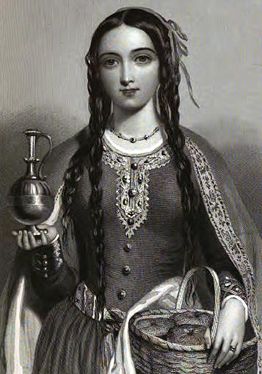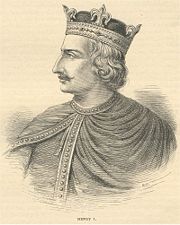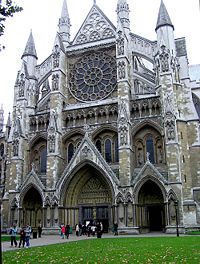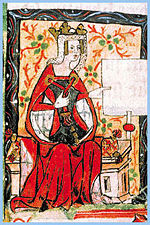Matilda of Scotland
| Matilda of Scotland | |
|---|---|
| Queen consort of the English | |

| |
| Consort | 11 November 1100 – 1 May 1118 |
| Consort to | Henry I |
| Issue | |
| Matilda of England William Adelin | |
| Royal House | House of Normandy House of Dunkeld |
| Father | Malcolm III of Scotland |
| Mother | Saint Margaret of Scotland |
| Born | c. 1080 Dunfermline, Scotland |
| Died | 1 May 1118 (aged 38) Westminster Palace |
| Buried | Westminster Abbey |
Matilda of Scotland[1] (born Edith; c. 1080 – 1 May 1118) was the first wife and queen consort of Henry I, she gave birth to four children, only two survived, Matilda, (1102-1167), Holy Roman Empress consort, and Countess consort of Anjou, called Lady of the English, and was named "ruler" of England when her father, Henry died, but was never accepted by the barons; and William Adelin, (1103-1120), sometimes called Duke of Normandy. From Matilda's descendants the Plantagenet royal line was established when her grandson, Henry II became king.
A well-educated woman, she brought both religious and cultural improvements to the court, and acted as vice-regent when her husband Henry was away from England.
Early life
Matilda was born around 1080 in Dunfermline, the daughter of Malcolm III of Scotland and Saint Margaret. She was christened Edith, and Robert Curthose stood as godfather at her christening—the English queen Matilda of Flanders (her future mother-in-law) was also present at the font and may have been her godmother. She had blond hair and blue eyes and was attractive.
When she was about six years old, Matilda and her sister Mary were sent to Romsey, England, where their aunt Cristina was abbess. During her stay at Romsey and Wilton, Matilda was much sought-after as a bride; she turned down proposals from both William de Warenne, 2nd Earl of Surrey, and Alan Rufus, Lord of Richmond. Hermann of Tournai even claims that William II Rufus considered marrying her. She was out of the monastery by 1093, when Anselm, Archbishop of Canterbury, wrote to the Bishop of Salisbury ordering that the daughter of the king of Scotland be returned to the monastery that she had left.
Marriage
After the death of king William II Rufus in August 1100, Henry quickly seized the royal treasury and the royal crown. His next task was to marry, and Henry's choice fell on Matilda. Because Matilda had spent most of her life in a nunnery, there was some controversy over whether or not she had been veiled as a nun and would thus be ineligible for marriage.
Henry sought permission for the marriage from Archbishop Anselm of Canterbury, who returned to England in September 1100 after a long exile (from William II). Professing himself unwilling to decide so weighty a matter on his own, Anselm called a council of bishops in order to determine the legality of the proposed marriage. Matilda testified to the archbishop and the assembled bishops of the realm that she had never taken holy vows. She insisted that her parents had sent her and her sister to England for educational purposes, and that her aunt Cristina had veiled her only to protect her "from the lust of the Normans." Matilda claimed she had pulled the veil off and stamped on it, and her aunt beat and scolded her most horribly for this. The council concluded that Matilda had never been a nun, nor had her parents intended that she become one, and gave their permission for the marriage.
Matilda and Henry seem to have known one another for some time before their marriage — William of Malmesbury states that Henry had "long been attached" to her, and Orderic Vitalis says that Henry had "long adored" Edith's character. Through her mother she was descended from king Edmund Ironside and thus Alfred the Great, and was a great-niece of Edward the Confessor and the old line of the kings of Wessex; the marriage represented a union between the new Norman rulers of England and the old Anglo-Saxon dynasty. This was very important as Henry wanted to help make himself more popular with the English people and Matilda represented the old English dynasty to the English people. In their children the Norman and Anglo-Saxon dynasties would be united. Another benefit of the marriage was that England and Scotland became politically closer; three of her brothers served as kings of Scotland and were unusually friendly to England during this period.
Queen
After Matilda and Henry were married on November 11, 1100 at Westminster Abbey by Archbishop Anselm of Canterbury, she was crowned as "Matilda," a fashionable Norman name. She gave birth to a daughter, Matilda, in February 1102, and a son, William, in November 1103, two other children died in infancy. As queen, she maintained her court primarily at Westminster, but accompanied her husband in his travels all across England, and, circa 1106–1107, probably visited Normandy with him. Well educated at both convents of Romsey and Wilton, she could increase the quality of literature and culture at court in the twelfth century. As a devout queen she could also exercise both lay and ecclesiastical patronage. She was a member of Henry's curia regis, and also served in a vice-regal capacity when Henry was away from court until 1118 when her son, William, was old enough to serve in her stead.
Her court was filled with musicians and poets; she commissioned a monk, probably Thurgot, to write a biography of her mother, Saint Margaret. She was an active queen, and like her mother was renowned for her devotion to religion and the poor. Historian William of Malmesbury (1080/1095–c. 1143) describes her as attending church barefoot at Lent, and washing the feet and kissing the hands of the sick. She also administered extensive dower properties and was known as a patron of the arts, especially music.
Matilda wrote many letters, many of which still exist. The bulk of her correspondence was with Anselm, archbishop of Canterbury who was the ranking ecclesiastic of England. She wrote to Pope Paschal II, Thurgot, a monk of Durham, Ivo, bishop of Chartres, emperor Henry V, and Hildebert, bishop of Lavardin. And some of their responses survive as well as letters from Marbod, bishop of Rennes and Herbert of Losinga, bishop of Norwich. Anselm went into exile in 1097 while William Rufus was king, but was recalled by Henry in 1100, but then went back into exile a second time, from 1103-06, during which time Matilda continued to write to him and to plead his case to Pope Paschal II and others.[2]
Matilda died on May 1, 1118 at Westminster Palace, and was buried at Westminster Abbey.
Children of Matilda
Matilda and Henry had four children but only two survived: Matilda of England, (1102-1167), Holy Roman Empress consort, Countess consort of Anjou, called Lady of the English. Matilda and Henry betrothed their daughter Matilda when she was seven years old to Henry V, Holy Roman Emperor, and from her marriage to Henry, she became Empress Matilda or Maud. The couple had no known children. When widowed, she was married to Geoffrey V, count of Anjou, by whom she became the mother of three sons, the eldest of whom, later became king Henry II, of England. Queen Matilda's second child was William Adelin, (1103-1120), sometimes called Duke of Normandy.
In order to secure the loyalty of Anjou, a long-time rival of Normandy, Matilda and Henry betrothed William to Matilda of Anjou, eldest daughter of Count Fulk V of Anjou in February 1113 near Alençon. Queen Matilda died in 1118 probably postponing the marriage which finally took place in June 1119 in Lisieux. Just a year later, young William died in the White Ship tragedy of November 25, 1120. The Prince and his companions had been crossing the English Channel from Barfleur in the White Ship, the swiftest and most modern ship in the royal fleet during the dead of night after an evening of drinking. It was in the middle of the night when the drunken helmsman rammed the ship into a rock in the bay. The crew and passengers were unable to lever the ship off the rock, or prevent the ship from filling with water; however, William and several of his friends managed to launch a life-dinghy. At the last minute, William dashed back to rescue his illegitimate half-sister, the Countess of Perche; when they and several others threw themselves into the small dinghy, it, "overcharged by the multitude that leapt into her, capsized and sank and buried all indiscriminately in the deep." [3] William's wife was on another ship at the time of the wreck, and survived him to become a nun and eventually, Abbess of Fontevrault.
Henry finally designated their daughter, Matilda, dowager Holy Roman Empress, as his heiress, marrying her to William's brother-in-law Geoffrey V of Anjou, (Plantagenet) and forcing his Barons to swear to uphold her rights; but on his death, the Barons reneged on their oaths on the grounds of coercion, and chose Henry's nephew, Stephen of Blois. The death of her only son and Henry's failure to produce a legitimate son from his second marriage to Adeliza of Louvain led to the succession crisis in English history known as The Anarchy. But finally, Matilda's grandson, Henry II became king in 1154. He married the powerful, Eleanor of Aquitaine and they had 11 children, two becoming kings of England themselves, Richard the Lionheart, and John I, firmly establishing the Plantagenet royal line.
Legacy
Matilda, like a few queen consorts, such as Phillipa of Hainault ruled England as a vice-regent while the king was away. Matilda did so until her son, William, was of age. She commissioned at least two histories, a life of her mother, Saint Margaret, from a monk of Durham, and an extended history of her family, the Gesta Regum Anglorum, from another monk William of Malmesbury, which was finished after her death and presented to her daughter, empress Matilda.
She was a pious woman and tried to care for the less fortunate of her realm for which the people christened her 'Good Queen Mold'. She died in 1118 at the age of 41 and was buried in Westminster Abbey beside Edward the Confessor, her ancestor. After her death, she was remembered by her subjects as "Matilda the Good Queen" and "Matilda of Blessed Memory," and for a time sainthood was sought for her, though she was never canonized.
From her grandson, Henry II, the Plantagenet royal line was established. He married Eleanor of Aquitatine with whom he had 11 children. Most of the royal houses of Europe were married into the Plantagenet royal family thanks to the diligence of Eleanor.
| House of Dunkeld Born: c. 1080; Died: 1 May 1118 | ||
|---|---|---|
| English royalty | ||
| Preceded by: Matilda of Flanders |
Queen consort of England 11 November 1100–1 May 1118 |
Succeeded by: Adeliza of Louvain |
George, Duke of Cumberland (1702-1707) · Mary of Modena (1685-1688) · Catherine of Braganza (1662-1685) · Henrietta Maria of France (1625-1649) · Anne of Denmark (1603-1619) · Philip II of Spain (1554-1558) · Lord Guildford Dudley (1553) · Catherine Parr (1543-1547) · Catherine Howard (1540-1542) · Anne of Cleves (1540) · Jane Seymour (1536-1537) · Anne Boleyn (1533-1536) · Catherine of Aragon (1509-1533) · Elizabeth of York (1486-1503) · Anne Neville (1483-1485) · Elizabeth Woodville (1464-1483) · Margaret of Anjou (1445-1471) · Catherine of Valois (1420-1422) · Joanna of Navarre (1403-1413) · Isabella of Valois (1396-1399) · Anne of Bohemia (1383-1394) · Philippa of Hainault (1328-1369) · Isabella of France (1308-1327) · Marguerite of France (1299-1307) · Eleanor of Castile (1272-1290) · Eleanor of Provence (1236-1272) · Isabella of Angoulême (1200-1216) · Berengaria of Navarre (1191-1199) · Eleanor of Aquitaine (1154-1189) · Matilda of Boulogne (1135-1152) · Geoffrey V, Count of Anjou (1141) · Adeliza of Louvain (1121-1135) · Matilda of Scotland (1100-1118) · Matilda of Flanders (1066-1083)
Notes
- ↑ She is known to have been given the name "Edith" (the Old English Eadgyth, meaning "Fortune-Battle") at birth, and was baptized under that name. She is known to have been crowned under a name favored by the Normans, "Matilda" (from the Germanic Mahthilda, meaning "Might-Battle"), and was referred to as such throughout her husband's reign. It is unclear, however, when her name was changed, or why. Accordingly, her later name is used in this article. Historians generally refer to her as "Matilda of Scotland"; in popular usage, she is referred to equally as "Matilda" or "Edith".
- ↑ Columbia University, Missouri: Epistolae Retrieved January 30, 2009.
- ↑ William of Malmesbury, from Marion Meade, Eleanor of Aquitaine.
ReferencesISBN links support NWE through referral fees
- Chibnall, Marjorie. The Empress Matilda: Queen Consort, Queen Mother, and Lady of the English, Blackwell, 1992. ISBN 9780631157373
- Hollister, Warren C. and Amanda Clark Frost. Henry I, New Haven: Yale University Press, 2001. ISBN 9780300088588
- Huneycutt, Lois L. "Matilda of Scotland: A Study in Medieval Queenship"." Rochester, NY: Boydell Press, 2003. ISBN 9780851159942
- Meade, Marion. From William of Malmesbury, in Eleanor of Aquitaine, London: Phoenix, 2002. ISBN 9781842126189
- Parsons, John Carmi and Bonnie Wheeler. Medieval Mothering, New York: Garland Pub., 1996. ISBN 9780815323419
External links
All links retrieved January 29, 2009.
- Columbia University, Missouri: Epistolae
- Nation Master
- Matilda of Scotland and the Development of Medieval Queenship
- Explore parliament website
Credits
New World Encyclopedia writers and editors rewrote and completed the Wikipedia article in accordance with New World Encyclopedia standards. This article abides by terms of the Creative Commons CC-by-sa 3.0 License (CC-by-sa), which may be used and disseminated with proper attribution. Credit is due under the terms of this license that can reference both the New World Encyclopedia contributors and the selfless volunteer contributors of the Wikimedia Foundation. To cite this article click here for a list of acceptable citing formats.The history of earlier contributions by wikipedians is accessible to researchers here:
The history of this article since it was imported to New World Encyclopedia:
Note: Some restrictions may apply to use of individual images which are separately licensed.


